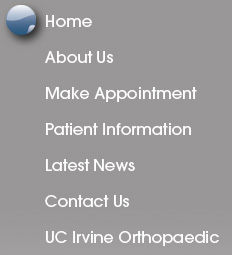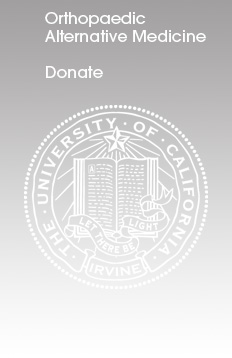|
Patient
Information
Appointment and General
Patient Information
949-515-5210
Patient Education - Here is some useful information
on common ailments that our doctors deal with daily. For more
information please click on any topic and it will redirect you
to a link with more information on that given topic.
Click below to see more information...
-
DOWNLOAD PATIENT FORMS HERE -
Foot & Ankle • Shoulder
Surgery
Hand & Elbow Surgery • Spine
Surgery
Spine Surgery (Educational Videos) • Trauma
Foot and Ankle - Steven
Ross, MD
| Bunions |
A bunion is a foot deformity that
occurs in the bone that is connected to the big toe.
Bunions are most commonly caused by wearing narrow or
unfit shoes for a long period of time. There are many
different non-surgical treatments that are used but 85-90
percent of patients that undergo bunion surgery are satisfied
with their results.
|
| Achilles
Tendonitis |
Achilles tendon is the largest tendon
in the human body and can withstand forces up to 1, 000
pounds. This happens to be the most frequent tendon that
gets ruptured due to overuse and inflammation of the
tendon. This can be treated by rest, anti-inflammatory
medication, and in some extreme cases surgery.
|
| Sprained
Ankle |
Sprained Ankles are a very common injury that approximately
25,000 people each day experience. This type of injury
can occur for anyone that may associate themselves
with physical activity or any other type of activity
where the foot can twist, roll or turn beyond its normal
motion. Surgical treatment is rare for this type of
injury but treatment can vary within each person.
|
| Post-Operating Instructions
for foot and ankle surgery |
The following general instructions are guidelines for
your post-procedure recovery at home. Due to medication
given during your stay, you may not remember these instructions.
Therefore, you should review these instructions before
your surgery and make sure to keep a copy at home. These
should be read and understood before your surgery and you
should ask your doctor if you have any questions about
these post-operating instructions. Please
Click HERE to download instructions.
top
of page
|
Shoulder Surgery - Ranjan
Gupta, MD
| Broken
Collar Bone |
A broken collarbone is a common aliment
found amongst children and athletes. A collarbone causes
the inability to move your arm without any pain. A broken
collarbone can be treated effectively without surgery
and can be restored to the natural movement that was
once allowed.
|
| Shoulder
Impingement/ Rotator Cuff Injury |
A shoulder impingement is one of
the most common pains in the shoulder. This pain is a
result of pressure that is felt on both the shoulder
blade and rotator cuff. Pain is often felt when the shoulder
is at rest and when in activity. Non-surgical and surgical
treatments vary from patient to patient.
|
| Shoulder
Instability |
Shoulder instability is a result of the shoulder when
it is forced out of its socket which is a result of a sudden
injury. There are two different forms of shoulder instability
which include subluxations and dislocations. Both surgical
and non-surgical methods are used to treat this type of
injury. |
| Arthritis
of the Shoulder |
There are three different types of arthritis of the
shoulder. The types include Osteoarthritis, Rheumatoid
Arthritis, and Posttraumatic Arthritis. This can be
treated by both surgical and non-surgical treatment
depending on the patient.
top
of page
|
Hand & Elbow Surgery - Ranjan
Gupta, MD - Neil
F. Jones, MD - Greg
Rafijah , MD
| Carpal
Tunnel Syndrome |
Hand numbness and pain is more commonly caused by
carpal tunnel. This happens as a result of swelling
and pressure on the median nerve. The most common causes
of carpal tunnel are heredity, extensive use of the
hand, and repetitive use of the hand and wrist. This
can be treated with medication, a splint or brace,
and in some severe cases surgery may be required.
|
| Trigger
Finger |
A trigger finger occurs when the motion of the tendon
that opens and closes the finger is limited, causing the
finger to lock or catch as the finger is extended. Trigger
fingers are more common in women than men. They occur most
frequently in people who are between the ages of 40 and
60 years of age. Trigger fingers are more common in people
with certain medical problems, such as diabetes and rheumatoid
arthritis. |
| Distal
Radius Fracture |
Distal radius fractures are very common. In fact,
the radius is the most commonly broken bone in the arm.
The break usually happens when a fall causes someone
to land on their outstretched hands. It can also happen
in a car accident, a bike accident, a skiing accident,
and similar situations.
top
of page
|
Spine Surgery- Nitin
Bhatia, MD - P.
Douglas Kiester.
| Conservative
Spinal Care |
Conservative spinal care is a treatment
which requires non-invasive approach which can include
medication or even less invasive approach to surgery.
The amount of time in which conservative care is used
varies within each patient.
|
| Minimally
Invasive Spine Surgery |
Minimally invasive surgery is a type
of surgery performed through small incisions and usually
requires small cameras. This type of surgery has been
introduced to reduce the amount of recovery time and
minimize the scars that are created during surgery.
|
| Lumbar
Spine Stenosis |
Lumbar spine stenosis is a narrowing
of the lumbar spinal canal. The narrowing of the spinal
canal is caused by a thickening of the spinal canal due
to arthritis. This can be treated with physical therapy,
cortisone shots, anti-inflammatory medications, and in
some cases surgery.
|
| Scoliosis |
About 2% of the population is affected
by scoliosis. Scoliosis is seen more likely between girls
than boys. Scoliosis is where the spine is bent beyond
its natural curves and can contribute to poor posture.
Scoliosis cannot be corrected by standing straight, it
can however be corrected with an orthopedic brace or
in extreme case surgery can correct this problem.
|
| Herniated
Cervical Disc with Radiculopathy |
Herniated cervical disc is when
cervical disk breaks producing pressure on the nerve
that exists within the spinal column. The nerve then
becomes irritated, swollen and inflamed. Treatment can
vary from medication, limited activity, physical therapy,
and surgery depending on the patient.
|
| Lumbar
Herniation Disc with Radiculopathy |
A disk herniation is when part of the center nucleus
gets ruptured and pushes through the outer edge of
the disk and toward the spinal canal causing pressure
on the nerve. This can be a result from sudden pressure,
smoking, or lifting something improperly. Treatment
can vary from rest, muscle relaxers, and surgery depending
on the patient.
top
of page
|
Spine Surgery (Educational Videos)
- Nitin
Bhatia, MD - P.
Douglas Kiester, MD
| Cervical Stenosis
and Myelopathy |
|
| Cervicogenic Headaches |
|
| Lumbar Spondyolysis
(Pars Defect, Pars Fracture) |
|
| Cervical Total Disc Arthroplasty |
|
| Low Back Pain |
|
| Cervical Disc Herniation
(Herniated disc in the neck) |
|
| Lumbar Disc Herniation
(Herniated disc in the low back) |
|
Trauma- Greg
Rafijah , MD
| Osteoporosis |
Osteoporosis is a disease of progressive
bone loss with an increased risk of fractures. This is
a major health problem that affects 28 million Americans
and can contribute to 1.5 million bone fractures each
year. There is not one common factor to what causes osteoporosis,
the only things that may contribute to osteoporosis is
age.
|
| Hip
Fracture |
Hip fractures are the most common
broken bone for patients over the age of 65 years old.
This is a serious health problem common among the elderly
men and women when they fall. In most cases, hospitalization
and surgery might be required.
|
| Wrist
Fracture |
This is the most common broken bone for patients under
the age of 65 years old. Some common symptoms of a
wrist fracture include swelling, pain in the wrist
and even deformity of the wrist. Treatments vary from
patient to patient.
top
of page
|
|




